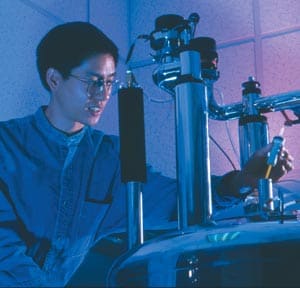A Shortcut Through Time: The Path to the Quantum Computer
George Johnson
2003 Jonathan Cape/Knopf 208pp £17.99/$24.00hb
Quantum computers could be faster and more powerful than conventional computers. Moreover, they could trigger a revolutionary new approach to information processing. That is the intriguing message conveyed by the science journalist George Johnson in this short book. He explains how this new approach could undermine the security of current cryptography protocols, lead to fast algorithms for searching databases, and offer ways of simulating complex quantum-mechanical systems. However, the full scope of quantum computers is unknown. It might well be beyond our imagination.
Those who wish to obtain a basic understanding of this exciting emerging technology – even those who have never been exposed to the mysteries of the quantum world – will find this book accessible and enjoyable to read. It starts with a gentle introduction to the concept of quantum superposition, explaining how it can open the door to a massive parallel computational power that is far beyond the reach of any classical supercomputer.
Having described this seemingly unlimited computational power, the author takes quite a few chapters before revealing that there is a significant catch. “Reading out” the quantum computer will not provide you with the array of answers calculated in parallel; rather, it will spit out only one, randomly selected answer. This feature of the quantum computer – and of other quantum systems in general – is called the collapse of the quantum wavefunction and has been the centre of philosophical debate since quantum mechanics was founded about a century ago.
Johnson wisely stays out of this debate but explains – without any mathematics – how one can profit from the parallel computation power, despite this wavefunction collapse. He then brings us to the heart of the matter, namely Peter Shor’s algorithm for factoring large numbers, its link to secret code breaking, as well as Lov Grover’s search algorithm. The chapters on these crucial issues help the reader to grasp the underlying ideas rather than understand all the details.
The later chapters explain what it might take to build a fully fledged quantum computer, which is – it is no secret – not yet technologically possible. But given the major efforts in key research centres around the globe, it is not unthinkable that crucial breakthroughs could take place in the near future. The book therefore reviews various approaches to quantum computation based on ion traps and nuclear magnetic resonance, while making clear that others systems also being explored.
Given the technological limitations of controlling quantum systems, quantum computation will unavoidably be prone to errors. If current optimism is to be maintained, it is crucial that we learn how to perform quantum error correction, which would “track” and “repair” faulty operations in a quantum computer. Significant theoretical progress has been made, and Johnson quite rightly dedicates a chapter to this important topic.
There is also an excellent chapter on quantum cryptography, which enables two parties to set up a secret “key” that would let them communicate securely using the quantum properties of photons. The final chapter outlines the hope that quantum computers might solve long-standing unsolved scientific challenges, such as protein folding and the “travelling salesman” problem.
So does the book succeed? “Writing this kind of book is like having two very different people breathing down your neck,” Johnson concludes. “The scientist keeps trying to grab the keyboard to qualify every other sentence with footnotes and equations. Meanwhile, the reader is prodding you to cut to the chase and get on with the story.”
As a scientist myself, I do indeed feel that some explanations are too brief to satisfy my desire to truly understand the issues at hand. However, I have a deep respect for the way in which the author has tried to convey the ideas of quantum computation to people without a background in quantum physics. I know that phrases like quantum cryptography, quantum computation and quantum teleportation can intoxicate the mind of the uninitiated and unleash fantasies in uncontrolled directions. After publishing a paper on experimental quantum teleportation, I once received a message from a religious sect thanking the research team for having proven what they believed in for so many years.
Given the complexity of the topic, the broad target readership, and the decision to keep the book short, A Shortcut Through Time is in my view a remarkable achievement by Johnson. It will help to guide the imagination of the reader into a fascinating future – one in which quantum mechanics might play a prominent role in communication and computation.




